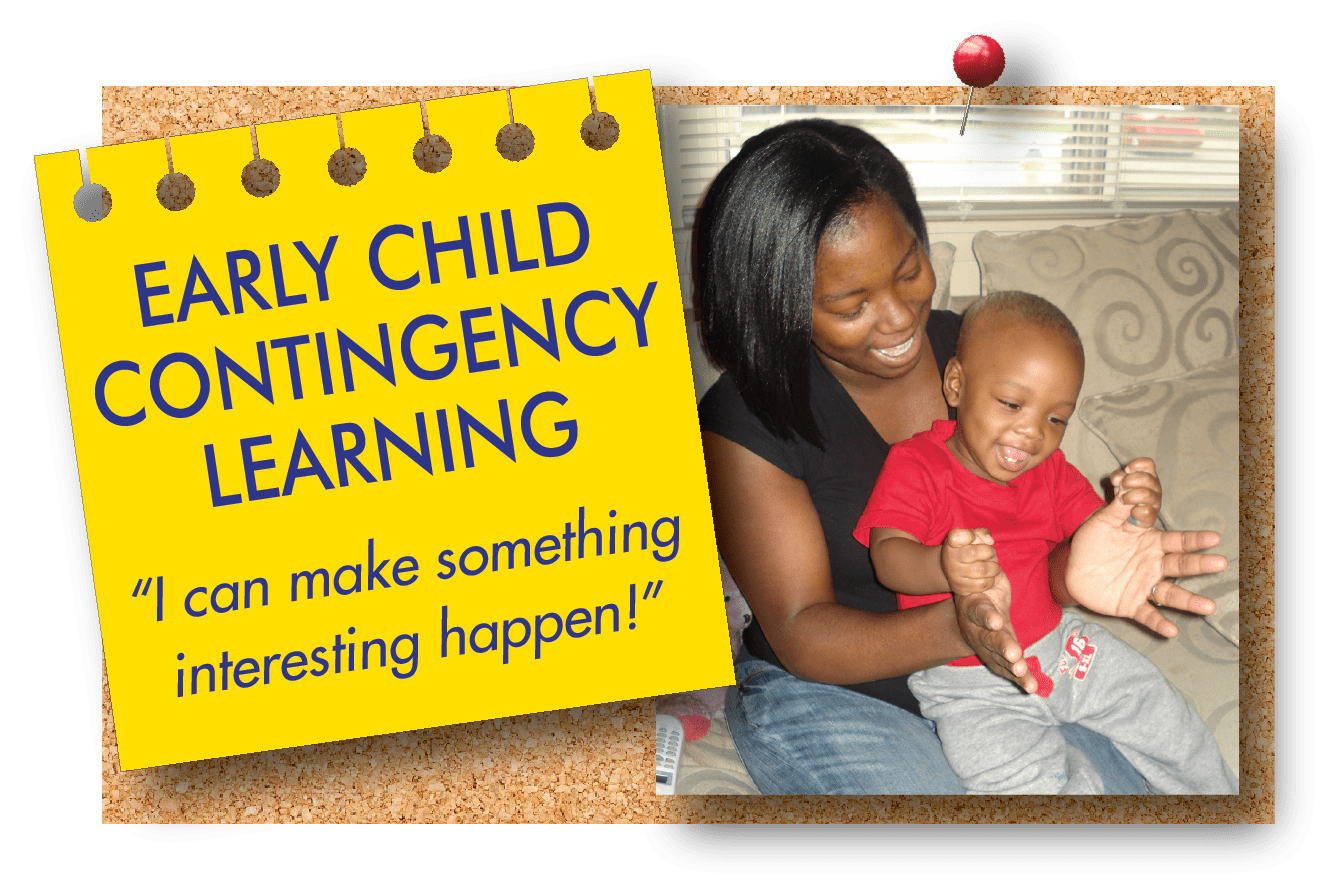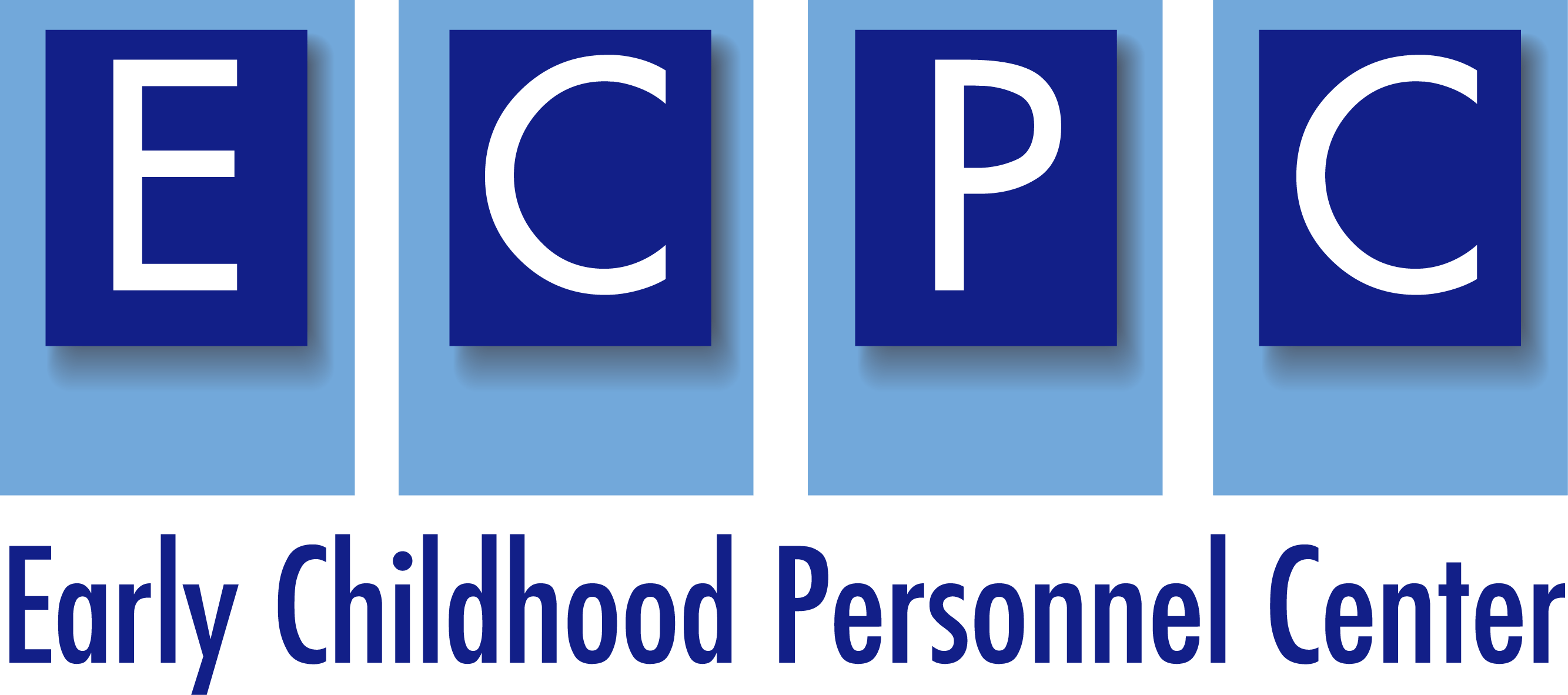
Definition
Early childhood contingency learning activities or games include opportunities for a child to use behavior to:
- Elicit or produce interesting consequences where the consequences are dependent on the child’s actions and behavior with people or materials
- Acquire an understanding or awareness that he or she was responsible for producing the interesting environmental effects
- Learn about what people, materials, and toys will do in response to a child’s behavior and actions
The term contingency learning refers to the relationship between a child’s actions and behavior, and what happens in response, where the response is dependent (contingent) on the child’s behavior.
Need2Know
Children with disabilities and significant developmental delays, compared to children without delays or disabilities, often take more time to make the connection between their behavior and the consequences of their behavior. Repeated attempts to elicit child responses by stimulating a child (called non-contingent stimulation) can impede rather than facilitate child learning. Carefully designed and implemented contingency learning games that pair child behavior with interesting effects are powerful ways to promote the learning of children with disabilities or delays. The benefits of child contingency learning extend to parents and caregivers in the form of parents’ increased positive affective behavior indicative of a sense of competence and confidence related to promoting child learning.
Child Engagement
- Children stay engaged in the learning games for longer periods of time
- Children maintain involvement in play with people and materials
- Children become more able to initiate play during contingency activities and games
Characteristics
The key characteristics of strengths-based child contingency learning games include:
- Identifying the behavior a child will use to produce environmental consequences
- Identifying child-specific reinforcers and environmental effects to pair with child behavior
- Developing both social and nonsocial learning games where child behavior elicits or is followed by interesting environmental consequences
- Engaging the child in learning games where there is a high probability of child actions and behavior having an environmental consequence (reinforcer)
- Using learning games where each game provides a child lots of opportunities to use behavior to have environmental effects and consequences
- Caregivers responding promptly and positively to child interactions during social learning games
- Maintaining the child’s use of contingency behavior by varying the environmental consequences to ensure sustained child interest and interaction
Child Outcomes
Early child contingency learning opportunities are effective for:
- Increasing child use of behavior to cause interesting things to happen
- Sustaining child interactions with people and materials
- Expanding the types of behavior a child uses to interact with people and materials
- Increasing child social-emotional behavior like smiling, laughter, vocalizations, and general excitement
Take a Look
Cause-and-Effect Learning Fun
Malia was pleased when she noticed that her infant son, Timothy, was turning his head to the side quite frequently. She decided to play a game when she was holding him in her arms. She already had observed that Timothy seemed captivated and enjoyed her humming a tune and dancing around as she held him close. So to play the game, Malila held Timothy in her arms and waited for him to turn his head toward her. Each time he turned his head toward her, she twirled him in a circle as she hummed a song. It was easy to play this game often, whenever she held him in her arms. It wasn’t long before Timothy showed that he “got” the connection between turning his head and getting Malia to hum and spin. He smiled and cooed as Malia spun him around, and before long began to grin as he began to turn his head. Timothy’s dad, Adam, was overjoyed when Malia showed him what Timothy could do, and began to play the game with him, too.
Interest-Based Games Delight Young Learner
Elena, an early interventionist, began working with Alex and his son, Thatcher, a couple of months ago. During those weeks, Elena and Alex observed Thatcher to identify things Thatcher liked, such as sounds and music, and things Thatcher was able to do, like moving his fingers, swiping his arm to the side, and stretching his leg to press with his foot. They used their observations to develop several learning games where, in each game, Thatcher would use one of these behaviors to make something he liked happen. They planned for Thatcher to move his fingers on Alex’s palm to get Alex to say “Patty cake! Patty cake! Baker’s man!” as he clapped Thatcher’s hands. In another game, they planned for Thatcher to stretch his leg to press a switch positioned by his foot to turn on a recorder that played a song he loved. A third game involved Thatcher swiping his arm to make bells ring as they hung from an activity bar. To Alex, it seemed slow going at first, and the hardest part of playing the games was giving Thatcher enough time to do the expected behavior. But in a short while, Thatcher was readily playing the games, squealing happily as he made the different sounds happen, and Alex could hear himself exclaiming, “He’s doing it!”
Learning Worth Celebrating
As Gabby read the card that her sister had sent to Dodd, Gabby’s 3-year-old son, she thought, “This is the first card Dodd ever has received.” The card congratulated Dodd for learning to play a game where he could get his mother to bounce him as he sat on his mother’s knee. Gabby had been learning about contingency games as a way to help Dodd learn that he could make fun and interesting things happen. Gabby had been observing Dodd slightly kicking his leg when she held Dodd on her lap. She also knew that Dodd loved bouncing and other movement. She devised a game where she would bounce Dodd on her knee a few times each time he kicked his leg. Gabby showed Dodd how the game worked, and then was patient, giving Dodd plenty of time to be able to kick his leg and get her to bounce him up and down. Each time, Dodd laughed with delight. It only took several times playing the game before Gabby could tell Dodd understood that he could make the bouncing happen. Gabby was so thrilled with his accomplishment that she told her sister about it. And her sister, as proud of Dodd as she was of all her other nieces and nephews, sent this wonderful card.
You'll want to try this:
To increase your understanding and use of early child contingency learning, consider trying this activity:
- Obtain permission from a parent of an infant or from staff of a childcare center to spend time observing infants during their everyday activities. Make a list of the different ways you see the babies expressing their needs and emotions. Which of the things the babies are doing or the ways they’re moving could be used as their response in a contingency learning game?
- Interview caregivers or parents of a baby to find out what things give the baby pleasure or capture his or her attention and interest. If, for example, the baby giggles and babbles happily when a caregiver smiles at him or her and gently tickles his or her feet, let that be the fun thing that happens after the baby performs a target behavior.
- Select a behavior that you saw the baby is able to do frequently, even if the behavior is subtle or not yet used purposefully. If you notice that the baby is able to make frequent leg movements, for instance, pair this behavior (leg movement) and the desirable consequence (smiles and foot tickles) to make a contingency learning game. While playing with the baby, watch and wait for leg movements. Then respond immediately with happy smiles and tickles. Wait until you see the behavior again, and repeat the fun reward.
- Use the Early Child Contingency Learning Checklist to observe a caregiver or parent interacting with a child or use the checklist to evaluate your interaction with a child to increase your understanding and use of early child contingency learning games. Make notes of which checklist indicators you observed or recorded and record the specific child behavior a child used to produce interesting consequences.
Additional Information
To learn more about contingency learning for young children, you can consult a variety of online resources including:
- I Made It Fun Because I Made It Happen video
- Powerful FUN with Responsive Playthings idea page
- Hooray for Me! idea page
- I Did It! practice guide
- Parent-Child Social Games, a practice guide
ECPC Practice Guides are produced by
the Early Childhood Personnel Center,
University of Connecticut Center for Excellence in Developmental Disabilities, www.ecpcta.org
The development of the ECPC Practice Guides is supported, in part, by the U.S. Department of Education, Office of Special Education Programs. The opinions expressed, however, are those of ECPC, and no endorsement by the Department or Office should be implied or inferred.





